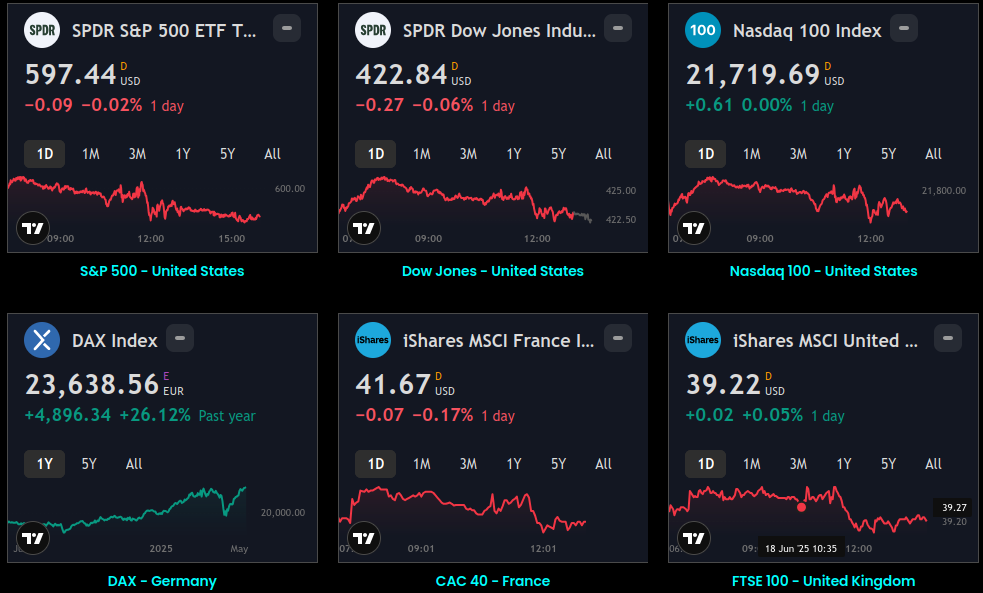WTF Dailies August 1, 2025
US stock futures slipped as the White House began to release the policy consequences of the expiration of President Trump's trade deadline, including a baseline tariff rate of 10% and increased levies on Canada.

- US stock futures slipped as the White House began to release the policy consequences of the expiration of President Trump's trade deadline, including a baseline tariff rate of 10% and increased levies on Canada.
- The White House issued a statement on Thursday evening indicating all trade partners would face a minimum tariff rate of 10%, though countries with a trade surplus with the US would be slapped with a higher baseline rate of 15%. The announcement also listed more than 70 specific countries and assigned each tariff rates between 15% and 40%. The new rates will take effect in seven days, perhaps providing a short window for furious negotiation.
- Separately, the White House said Trump signed an executive order, hiking tariffs on Canada from 25% to 35%. The new rate for Canada is set to go into effect on Friday, according to the statement.
- Only select US trading partners managed to negotiate trade agreements before Trump's unilateral Aug 1. deadline.
- Trump announced on Thursday that Mexico would get a 90-day extension of the tariff pause currently in place, and revealed a flurry of other deals and demands in the hours leading to the deadline, alongside a week long delay in implementation for many of the duties.
- Asian stock markets traded mixed on Friday amid growing concerns over U.S. trade tariffs ahead of a key deadline, while South Korean shares fell sharply after the government unveiled plans to raise taxes on corporations and stock investors.
- Investor sentiment was also shaped by a series of regional economic releases, including manufacturing activity surveys from China and Japan, South Korea’s latest trade data, and Australia’s second-quarter producer price figures.
- The fragmented structure of the tariffs meant markets responded differently depending on each country’s trade exposure and product mix, leading to mixed moves in Asia.
- Japan’s Nikkei 225 traded 0.4% lower, while the broader TOPIX index rose 0.4%.
- Singapore’s Straits Times Index edged 0.3% higher, while Australia’s S&P/ASX 200 dropped 0.8%.
- Chinese markets were muted on Friday after sharp losses in the previous session. The Shanghai Composite index was little changed, while the Shanghai Shenzhen CSI 300 tarded largely flat.
- Hong Kong’s Hang Seng index was also unchanged on Thursday.
- Futures for India’s Nifty 50 were largely muted on Thursday, while Malaysia’s KLCI index jumped 1%.
- In Seoul, the KOSPI index dropped more than 3% as new finance ministry proposals revealed plans to increase both corporate income and investment taxes.
- The top corporate tax rate would rise from 24% to 25%, and all corporate tax brackets would increase by one percentage point.
- Securities transaction tax would go up to 0.05% on KOSPI and 0.2% on KOSDAQ. The capital gains tax threshold for major shareholders would be lowered sharply from 5 billion won to 1 billion won.
- These measures aim to restore public revenue lost amid two years of slowing growth and tax cuts by the previous administration.
- China’s manufacturing sector unexpectedly shrank in July, as a drop in export orders and weak domestic demand weighed, the S&P Global PMI data showed on Friday.
- In Japan, the S&P Global survey revealed that Japan’s manufacturing activity contracted in July, reversing the brief stabilization seen in June, due to sluggish demand.
- Meanwhile, South Korea’s exports rose for a second month in July, driven by strong chip demand and front-loaded shipments ahead of U.S. tariffs.
- In Australia, data showed that producer prices rose below forecasts in the second quarter, with annual price growth easing to its slowest pace in nearly four years, keeping bets alive for another rate cut by the Reserve Bank of Australia.
Market Close
- Global equity markets were under pressure today as investors reacted to President Trump’s newly announced tariff rates targeting a range of countries. While the updated rates are expected to generate additional tariff revenue, they appear to have also reignited concerns about potential economic headwinds, especially as markets have recently rallied to new highs. Elsewhere, the mega-cap tech stocks didn't help provide support today as they did earlier in the week. Amazon shares dropped 8% following a disappointing profit outlook, while Apple gave up earlier gains despite reporting better-than-expected sales.
- Adding to the cautious sentiment was a weaker-than-expected U.S. employment report. Job gains fell short of expectations, and downward revisions to the prior two months suggest a notable cooling in the labor market. This slowdown may prompt the Federal Reserve to consider rate cuts as early as September. The dollar traded lower against major currencies amid rising rate-cut expectations, while bond yields fell across the curve. The 10-year Treasury yield dropped to 4.21%.
- The White House has released updated tariff rates ahead of today’s deadline extension, impacting imports from several countries. Rates range from the 10% global minimum to as high as 41%. Among the hardest hit are Switzerland (39%), Canada (35%), South Africa (30%), and Taiwan (20%).
- Generally, a 10% tariff applies to countries with which the U.S. maintains a goods trade surplus. A 15% rate is applied to countries that have reached agreements and with which the U.S. runs a modest trade deficit. Higher rates target countries that have not struck deals and with which the U.S. runs significant trade deficits.
- Additionally, a 40% tariff will be imposed on imports transshipped through third countries to circumvent tariffs. The new tariffs will take effect next Friday, allowing a brief window for further negotiations. Several countries have indicated interest in seeking reduced rates through ongoing bilateral talks.
- Based on today’s announcement, the effective average tariff rate is expected to rise to approximately 18%, a sharp increase from last year’s 2.5% but still below the previously proposed 25% rate from April 2. While the country-specific rates help reduce uncertainty around the tariff regime, new sector-specific tariffs—particularly in semiconductors, pharmaceuticals, and other key industries—are anticipated in the coming weeks. In our view, the higher tariffs may temporarily elevate inflation and act as a drag on economic growth. However, the recently passed tax bill could provide a partial offset, as tariff revenues are expected to be recycled into the economy through tax cuts.
- The U.S. economy added just 73,000 jobs last month, falling short of the 100,000 expected. Additionally, sharp downward revisions to May and June figures—totaling 258,000 fewer jobs—bring the three-month average to just 35,000, marking the slowest pace of hiring since 2020. Despite the slowdown, the unemployment rate remains historically low, ticking up slightly to 4.2% from 4.1%. Wage growth continues to outpace inflation, offering some support to household spending. Health care remains the primary driver of job creation, while the manufacturing sector shed jobs for the third consecutive month.
- From a market perspective, the softer data may prompt a pause in equity momentum while strengthening the case for Federal Reserve rate cuts in the coming months. Bond markets are now fully pricing in two rate cuts by year-end, with the probability of a September cut surging from 40% to 94%.
Global Indices:

Active Stocks:

Stocks, ETFs and Funds Screener:

Forex:

CryptoCurrency:

Events and Earnings Calendar:

This daily briefing is curated from a wide range of reputable sources including news wires, research desks, and financial data providers. The insights presented here are a synthesis of key developments across global markets, intended to inform and spark thought.
No Investment Advice: This content is for informational purposes only and does not constitute investment advice, recommendation, or endorsement.
Timing Note: Each edition is assembled based on the market context available at the time of writing. Timing, emphasis, and interpretations may vary depending on global developments and publishing windows.

















